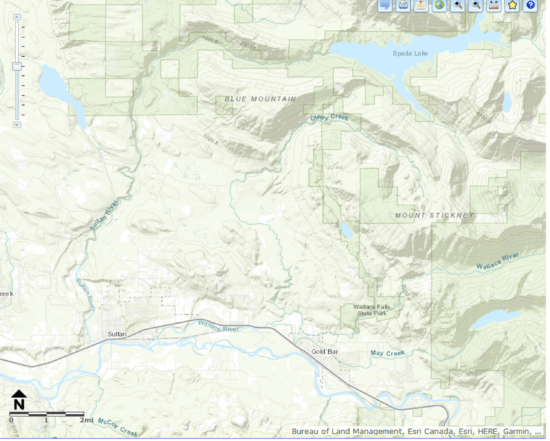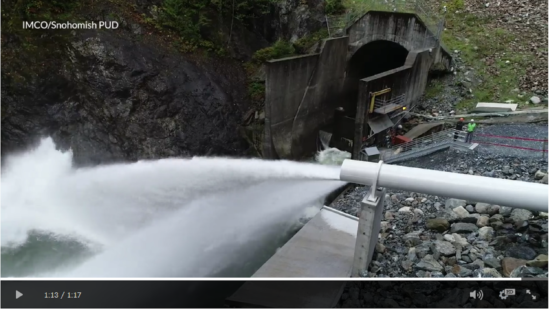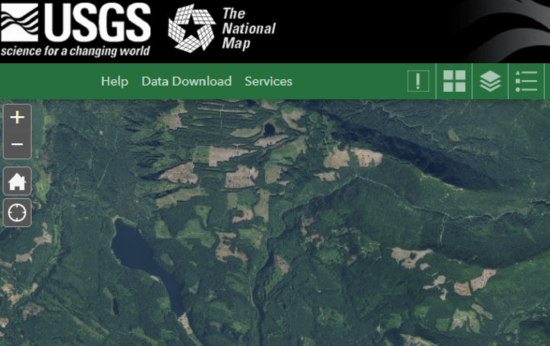Not So Fast That Fishing’s The Reason For Sultan Wild Steelhead Woes
The head of a longtime fishing organization is expressing disappointment with his local utility after it claimed summer angling is the reason wild winter-run steelhead aren’t recovering in part of a popular Western Washington watershed.
Mark Spada says that his Snohomish Sportsmen’s Club has “always had a good working relationship” with the county public utility district and has tried to work to improve fishing opportunities with them, but “(P)lacing blame on the recreational steelhead fisherman for a poor return is short sighted and unjustified.”

Spada, who recently helped put on a kids fishing day a bit higher up in the Skykomish River, was reacting to stories in The Herald of Everett and on Q13.
Both pieces mostly shared the viewpoint of the utility, which operates a dam on a tributary of the Sky, the Sultan River.
While one reporter talked to a random angler on the water and the other to a regional fisheries manager, Spada felt PUD could have done a better job beforehand.
“I hope in the future you’ll look to work with the recreational community to find answers to difficult fish management questions, and not take the low road to incite public perception,” he wrote to Larry Lowe, a Snohomish County PUD fisheries biologist, yesterday morning.

SPARKING THE SITUATION ARE DECLINING STEELHEAD RUNS and a recent statewide rule change that moved the opening day of fishing on the Skykomish from June 1 to the Saturday of the long Memorial Day Weekend as part of a WDFW regulations simplification drive.
In an email to Northwest Sportsman, Spada says he has fought for an earlier opener for years.
“The recreational fishing industry is in dire straits right now, and we need every single day of angling opportunity we can get,” he said. “(It) just makes good business sense to be open on a holiday weekend.”
With the scenic Skykomish the only summer salmon and steelhead bank and boat fishery of consequence in all of Western Washington this season, hundreds of anglers took advantage of the long weekend to get afield too, packing into the river’s accesses.
WDFW catch stats show that 338 were interviewed by creel samplers on May 25 and 26, including 259 at the Sultan River, Ben Howard and Lewis Street put-ins and take-outs, and another 79 up at Reiter Ponds.
Overall they kept 16 hatchery kings and 28 hatchery steelhead, releasing one wild king and 18 wild steelhead.
Not the world’s best fishing by any stretch, but those few wild steelhead are at the crux of PUD’s beef.
“We believe (angling rules) are impeding the recovery of these fish and they’re controllable, and we have to do all we can do,” utility natural resources manager Keith Binkley told The Herald‘s Julia-Grace Sanders.
PUD says it has spent $21 million of its ratepayers’ money to promote fish recovery in the Sultan River and that their monitoring shows 11 percent of the trib’s wild winter-runs are “still en route up the Skykomish” as of the old June 1 opener, and 26 percent as of this year’s late May opener, per the paper.
(The 2020 start of season would fall on May 30 because of how the calendar changes from year to year.)
THOSE SPAWNER FIGURES WILL RAISE EYEBROWS.
According to WDFW, greater than 95 percent of all wild winter steelhead in the Skykomish-Snoqualmie-Snohomish have already finished spawning by June 1.
Now, the Sultan is not the Sauk-Suiattle, home to large ice fields in the Glacier Peak Wilderness that keep those rivers colder longer and have led their steelhead to spawn later than any other stock in the state, but WDFW does allow that its fish do make redds later than others in the Snohomish watershed.
However, it’s unclear whether that timing has also been unnaturally skewed by cold water coming out of PUD’s Culmback Dam, which has been on the upper Sultan since 1965 and was raised 60-plus feet in 1984.
Up until recently, water was released “from the base of the reservoir, which is naturally colder than water near the top,” per the utility, but a modification now draws off and mixes in warmer surface water, making the river below the impassable dam more fish friendly.

It follows on 2016’s removal of a PUD diversion dam that had blocked salmon and steelhead passage at river mile 9.7 since 1929.
Good on them for checking off federal dam-relicensing requirements and doing more for fish, but if WDFW stats are any indication, fisheries are likely coming in well below allowable impact rates.
NMFS allows the agency and the Tulalip Tribes to kill up to 4.2 percent of returning Endangered Species Act-listed wild steelhead during their hatchery-directed winter and summer seasons through this October.
This year’s native winter steelhead run came in well below forecast and it won’t be known for some time how many were impacted during the December-January-February season, but all of 1.9 adults died during the first two weekends of the summer fishery.
That’s based on the 19 caught and released, as required, and a standard 10 percent mortality rate on steelhead put back in the water.
According to WDFW, those nates were also mostly kelts — winter fish that had already spawned and were returning to saltwater.
(Scott Weedman of Three Rivers Marine in nearby Woodinville fished the opener and believes those wild fish were actually mostly summer-runs, probably headed to the forks of the Skykomish.)
With an estimated 1,000 back this year, the loss of those 1.9 fish amounts to a 00.19 percent impact rate out of the maximum of 4.2 percent.

NOW, I’M NOT SAYING THE SULTAN FISH AREN’T IMPORTANT, not for one second.
Having put in some pretty good growing-up years along its banks and in the hills above the paved end of Trout Farm Road, I’m more than a little partial to the system and I want to see its steelhead and coho returns blow up like the river’s pink runs did.
I’m also realistic.
Fishing seasons that have been going on for decades are not the reason wild steelhead are suddenly struggling in the watershed, nor keeping them depressed.
That’s primarily due to massive, long-term habitat alterations — logging, diking, developing — that have reduced spawning and rearing water for fish.
I know it’s not PUD’s land, but I sure hope they’re paying close attention to any proposed clearcutting above either side of the rain-prone gorge of the Sultan below their dam.
But then again, maybe it’s easier to take on minnows like fishermen and miners than the state’s massive 2×4 industry.
Then there’s increasing pinniped predation on outmigrating smolts and returning adults.
And let’s not forget 2015, The Blob year, which shriveled streams in the Skykomish system and probably is playing no small part in recent years’ low steelhead returns.

EVEN SO, P.U.D. IS MAKING A BID TO TWEAK the fishing regs, asking WDFW to push its summer opener back to June 15, restrict the use of bait and limit angling at the mouth of the Sultan, per The Herald.
“We need to now, more than ever, be protecting these fish,” another PUD staffer told the paper.
WDFW’s ear is bent and they are mulling options.
Who knows what might come out of this, perhaps keeping the early opener above the Sultan or Mann Road Bridge, where hatchery steelhead predominate, and later below the mouth of the Sultan?
But that would also impact the summer king fishery, which is almost entirely between there and Monroe’s Lewis Street Bridge.
“That’s going to be the part that’s the biggest struggle — to protect steelhead and provide Chinook opportunity,” acknowledges Edward Eleazer, WDFW’s regional fisheries manager.
I don’t know how this one is going to end, but with how hugely important of a fishery the Skykomish has become in this day and age of shrinking opportunities, stay tuned.
